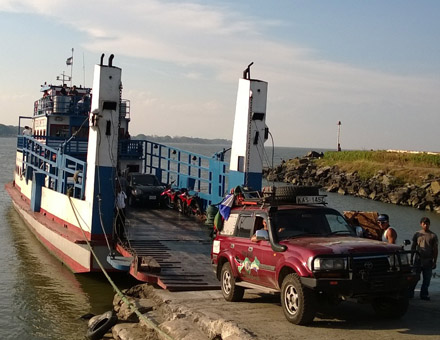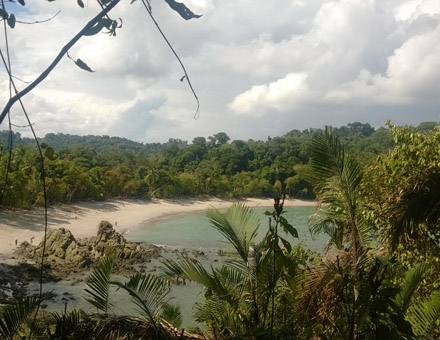
Nicaragua and Costa Rica - I had very diverging images of these two Central American countries bordering each other. Nicaragua - a country known for all the wrong reasons: Zomoza Dictatorship, Sandinista Revolution, Contra War. In contrast, Costa Rica - a stable democracy which has successfully embraced eco-tourism and markets itself with the eye catching slogan "Pura Vida" - Pure Life!
Coming from crime-ridden Honduras, we are relieved to find out that Nicaragua is considered one of the safest countries in Latin America. Granada, the country's long time capital, immediately charms us. Founded in 1524, it is the oldest city in the New World and drips with photogenic elegance - a picture postcard at every turn!
If Granada was Madrid, Leon would be Barcelona, its bitter rival city. Before coming here, we were told that many people fall in love with Granada, but most of them leave their heart in Leon. Leon is Nicaragua at its fiercest and most passionate, home to intellectuals and liberals and buzzing with energy and all-week happening nightlife. It was the heartland of the Sandinista Revolution against the brutal Somoza dictatorship in the late 1970s and "Revolution" seems to be in Leon's genes. Walking through town, we see graffiti with political messages on almost every wall – one of them proclaims "George Bush - enemy of humanity". A couple of things need fixing at Pele and I spend an entire afternoon at a garage. While the two mechanics and brothers - Filiberto and Xavier - repair Pele, we talk about life in Nicaragua. I am impressed about how articulate they express their views on both domestic and global matters.
We continue our journey to Lake Nicaragua, the largest lake in Central America, and take a ferry to Isla de Ometepe, an island in the lake. Approaching the island, we are awed by its two towering volcanoes. One of them, Volcan Concepcion, is still active and rises spectacularly 1600 Meters straight out of the lake. Two days later early in the morning, we find ourselves at its base. Fog blankets the mountain slopes, luckily for us as it protects us from the fiery rays of the sun and conceals the magnitude of the task ahead. The trail is extremely steep and rough, strewn with large volcanic boulders overgrown with moss. Initially, we walk through dense forest which gives way to bushy high altitude vegetation. After a grueling climb of almost 6 hours, we are rewarded at the top with cloud swept views of the steaming crater, Lake Nicaragua and several volcanoes around. When we lie down at the edge of the crater, we can feel intense heat from the earth underneath. Then the descent begins – a torture for our muscles which over the last couple of weeks haven't done much exercise except moving Pele's accelerator and brake pedal. Three days later, we still feel muscle cramps!
The next day, we relax at the beautiful Playa Santo Domingo right below the volcano and experience how Nicaraguans celebrate Easter at the beach. It is packed with families barbequing and swimming, and with people drinking beer at beach bars that emit ear splitting music. There are countless vendors and even a couple of enterprising touts setting up a Nicaraguan version of roulette right at the beach. The next morning, the beach has changed completely – the Nicaraguan revelers have gone back to their towns. The beach is completely deserted and I enjoy a beautiful morning walk with fantastic views of Volcano Concepcion high above.
 Taking the ferry back across Lake Nicaragua, we arrive just in time to observe a joyful parade at the edge of the lake. We ask some locals what this is about and are told that today is the name-day of the local patron San Jorge. All over town, people dance to Caribbean music played in the streets. At the Central Square, a stage has been set up for a concert and is surrounded by carousels. Most of these are being pushed by hand but there is one exception – a diabolically looking Ferris wheel! It is controlled by an operator who sits on its engine just like on a tractor. As we arrive, he has his hands full with a bowl of tacos. In between taking bites from it, he manages to operate the engine handles and shifts into a higher gear which sends the Ferris wheel into an unbelievable speed. I expect to see the gondolas flying off into the night sky any moment, driven by forces stronger than the decade old screws connecting them to the wheel. The operator doesn't seem disturbed by the screams of his passengers - some out of joy some out of horror and fear - and finishes the last bite of his tacos before changing into a lower gear and reducing the speed of the wheel.
Taking the ferry back across Lake Nicaragua, we arrive just in time to observe a joyful parade at the edge of the lake. We ask some locals what this is about and are told that today is the name-day of the local patron San Jorge. All over town, people dance to Caribbean music played in the streets. At the Central Square, a stage has been set up for a concert and is surrounded by carousels. Most of these are being pushed by hand but there is one exception – a diabolically looking Ferris wheel! It is controlled by an operator who sits on its engine just like on a tractor. As we arrive, he has his hands full with a bowl of tacos. In between taking bites from it, he manages to operate the engine handles and shifts into a higher gear which sends the Ferris wheel into an unbelievable speed. I expect to see the gondolas flying off into the night sky any moment, driven by forces stronger than the decade old screws connecting them to the wheel. The operator doesn't seem disturbed by the screams of his passengers - some out of joy some out of horror and fear - and finishes the last bite of his tacos before changing into a lower gear and reducing the speed of the wheel.
As we walk over the square and listen to the band playing, I keep looking at the Ferris wheel with a combination of fascination and terror. Finally, I realize that I have to try it out as otherwise I will always ask myself what it would have been like. Five minutes later, I am being propelled through the Nicaraguan night – no Disneyland roller coaster can compare to this as in addition to the revolving Ferris wheel each gondola rotates on its own axis which results in literally mind-blowing G-Forces. I am trapped in a gondola and feel scared like probably never before and send several prayers to the heavens, asking for the screws to hold and the ride to end. Finally, heaven hears my prayers – or the operator has finished his next portion of tacos!
We say good bye to Nicaragua feeling captivated – in spite of its troubled history it has a positive energy and offers intriguing colonial towns, pristine beaches and muscle-cramping volcanoes, and has hardly been discovered by international tourism yet. The latter can't be said of Costa Rica which is thronged by European and American tourists. We visit one of Costa Rica's many natural highlights, National Park Manuel Antonio on the Pacific Ocean which has stunning beaches and dense tropical forests full of wildlife. We enjoy a leisurely morning exploring the trails and a wonderful afternoon relaxing under swaying palm trees and swimming in the gentle waves of the turquoise Pacific before ending the day at a cliff-side restaurant as the sun sets the horizon ablaze.
 Costa Rica is an explosion of intense colors and natural contrasts and with a long shoreline along both the Pacific Ocean and the Caribbean. As the crow flies, they are less then 120km apart but driving across through Costa Rica's mountains takes us almost an entire day, starting at a breezy Pacific beach and ending at the steamy Caribbean basin. It is a breathtaking journey, initially through banana plantations and dense forests, then climbing on extremely rough roads into a cloud forest and to coffee farms on incredibly steep hills, past tiny villages and with views of huge volcanoes.
Costa Rica is an explosion of intense colors and natural contrasts and with a long shoreline along both the Pacific Ocean and the Caribbean. As the crow flies, they are less then 120km apart but driving across through Costa Rica's mountains takes us almost an entire day, starting at a breezy Pacific beach and ending at the steamy Caribbean basin. It is a breathtaking journey, initially through banana plantations and dense forests, then climbing on extremely rough roads into a cloud forest and to coffee farms on incredibly steep hills, past tiny villages and with views of huge volcanoes.
In addition to its natural beauty, Costa Rica is blessed in several other ways. Its colonial path diverged from that of other Latin American countries in that a powerful landholding elite and slave-based economy never gained prominence. Instead of large estates, small farms developed which resulted in a far more equal distribution of wealth when the country rode to prosperity during the coffee boom in the 1940s. Costa Rica has also been lucky to have some visionary leaders. A hundred years ago, they introduced free public education, a guaranteed minimum wage and child protection laws, and in 1949, President Ferrer built a modern welfare state and, most extraordinarily, abolished the military. Costa Rica seems to have done well with its unique model as an unarmed democracy – contrary to its Central American neighbors, it hasn't had a single military coup in the last 60 years and has directed spending of the money it saves from not having an army into health care, education, protection of natural resources - one third of Costa Rica is protected by National Parks or private conservancies - and tourism development.
Pura Vida – Pure Life – is a mantra that captures the Costa Rican way of life and it is more than a marketing slogan. It might be worthwhile for Kenyan and other leaders to study the Costa Rican model and see what they can learn from this tiny but remarkable country.

